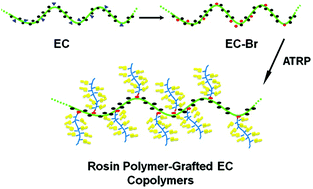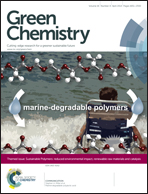Integration of renewable cellulose and rosin towards sustainable copolymers by “grafting from” ATRP†
Abstract
A class of sustainable and renewable cellulose–rosin copolymers were prepared by immobilizing rosin-derived polymer chains on the backbone of ethyl cellulose (EC) by “grafting from” atom transfer radical polymerization (ATRP). Four different rosin based polymers derived from dehydroabietic acid (DA), one of the major resin acids in natural rosin, were attached to 2-bromoisobutyryl-functionalized EC. Meanwhile, DA-grafted EC was prepared by the simple esterification reaction between DA and EC. Kinetic studies showed that the polymerization of all monomers was controlled. These grafted copolymers adopt a worm-like or rod-like structure in tetrahydrofuran, verified by light scattering experiments. These copolymers have a tunable glass transition temperature and higher thermal stability in contrast to EC. Surface morphology by AFM analysis indicated good film-forming property when rosin polymers were grafted from EC. Additionally, the introduction of DA and rosin polymers remarkably enhanced the hydrophobicity of EC. The static contact angles of all these modified copolymers are above 90°. XPS analysis revealed that the surface of these rosin-modified EC copolymers was dominated by a hydrocarbon-rich rosin moiety. The UV absorption of modified EC composites is indicative of their potential application in UV-absorbent coating materials.


 Please wait while we load your content...
Please wait while we load your content...